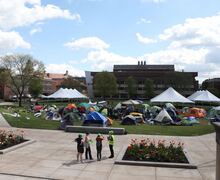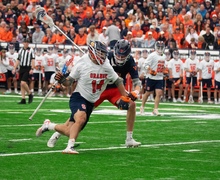Going mobile
Once Vincent Appel gutted the inside of a used recreation vehicle in freezing January temperatures, the fifth-year Syracuse University architecture student realized working on the Mobile Literacy and Arts Bus was more than just an assignment for class.
The project turned into a way for him to reach out to the Syracuse community. Nine SU undergrad students and one graduate student renovated an RV transforming it into the M-LAB, a mobile classroom for local high schools to use.
‘Local high schools just lack space and resources, and this bus is part of the solution, Appel said.
The M-LAB started as a project for a social sculpture (SCU 300/500) class, taught by Marion Wilson, a professor and director of community initiatives for the College of Visual and Performing Arts.
The purpose of the class was to make a public artwork that can involve the community instead of just a sculpture that simply sits there, said Arjan Zazueta, a graduate assistant in the class.
The class originally was intended for a single semester for fall 2007, Wilson said. But the bus didn’t even get started until the winter months of the spring semester in 2008. The project began as Wilson looked for ways to be involved with Scholarship in Action, a program designed to have Syracuse University involved with the local community.
What prompted Wilson to begin the project were the stories she heard about the lack of space in the public schools.
‘When we heard about men’s bathrooms being used as classrooms,’ Wilson said. ‘We really got a feel for how bad it was.’
Everything from the design of the actual bus to making the pillows for the interior were the ideas of architecture and sculpture students. Design for the bus also came from collaborative meetings with focus groups made up of public school students, who offered their thoughts on how the bus should work.
The outside of the RV’s driver’s side has ‘M-LAB’ spray painted in bright colors. As you enter, the bus has large, open space, with a white ceiling and magnetic white-board walls. Wilson said a centerpiece of the bus is the floor, which took six months to create and is made of a composite of reused scrap wood.
The bus is outfitted with a photo lab, consisting of four laptops, two photo printers and 40 digital cameras, courtesy of a $150,000 donation from Verizon Communications Inc. The money will also go toward the staffing of the bus and for its fall 2008 use. In addition, the bus will have a projector, so the students can show their work. Wilson hopes the bus will be used for other things besides photography, such as a gallery for work, a design studio or a creative writing workshop.
Wilson recalled one time when directors of SU’s architecture and sculpture programs contacted her asking for the students to return to their class work. The M-LAB was unveiled at Nottingham High School on April 4, as part of a preview for the students who would be using the bus. The M-LAB also will be on display at MayFest next Tuesday.
‘The students had a great reaction to the bus,’ Appel said. ‘It was great to see them make connections the moment they got on.’
The M-LAB was funded by a grant, presented by Sen. David Valesky (D-N.Y.), in the amount of $15,000. Robert Pomfrey, president of local real estate company POMCO, matched this grant with a donation of $30,000.
‘At first I thought the course was going to be like pimp my truck,’ said Jessica Posner, a fifth-year sculpture student. ‘But then it turned out to be a pretty important project.’
Appel plans on working on the bus during the summer by adding the access ramp and also coming back to see the progress in fall 2008. For Appel, the many hours spent working through the Syracuse winter were worth it.
‘I know it sounds sappy,’ he said, ‘but I was really impressed by how this project brought together families, friends and the community.’
Published on April 14, 2008 at 12:00 pm




